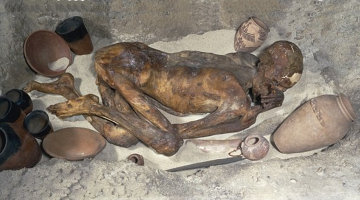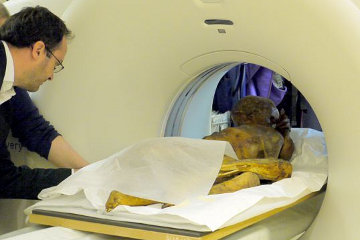The Murdered Red-head
Mummification has a long history in Egypt, but of course the intricate process did not spring fully formed from some Egyptian priest's imagination. If the experts are to be believed, the idea for mummification first came when someone unknown genius noticed that bodies buried in the hot dry sand were preserved when, years later, the sand blew away, exposing their remains.
The result was a deliberate attempt at preserving the body by wrapping it in mats or placing it in a reed coffin. Unfortunately this had the effect of keeping the dessicating sand away from the body and instead of preserving the flesh, this step had the effect of allowing decay to take place. Rather than give up, however, the ancient morticians continued to experiment and eventually hit on the idea of using salt - natron - to dry out the body, followed by a coating of tar or resin to make the dried out shell water proof.

| |
| Gebelein Man or 'Ginger' as the British Museum staff call him. |
If you go to the British Museum, you can get this information from a display in the Egyptian gallery upstairs where two bodies are strategically placed to illustrate the stages in the invention of mummification. The first, a pre-Dynastic burial from Gebelein, is a man curled up in the fetal position. He is displayed face-down, presumably as he was found, surrounded by the pots and dishes of his grave goods. One of the striking things about him is that his skin is all there apart from a patch on the front of his skull. Another thing is the few wisps of reddish hair on the back of his head.
"Ginger", as museum staff affectionately refer to him, is something of an icon for ancient Egypt and for the British Museum. He is the second-most popular exhibit after the Rosettta Stone and thousands of tourists every day crowd around his reconstructed gave to gape at this reminder of human mortality. He was brought to the British Museum in 1901 and installed in sealed case to continue the preserving effect of Egypt's dry conditions. Recently, for the first time in over a century, Ginger's sleep was disturbed.
Just as early Twentieth Century archaeologists delighted in unwrapping pharaohs for the benefit of tourists, so late Twentieth and early Twenty-first Century archaeologists queue up to have their mummies scanned and x-rayed. This is a much more defensible practice, for not only is it non-invasive and non-destructive, but it frequently reveals much hitherto unknown information about the dead person - and in this case the museum experts have struck gold.

| |
| The pre-dynastic mummy from Gebelein being fed into the CAT Scanner at Cromwell Hospital. |
Just under Ginger's left shoulder-blade there is a small slit, so small that it is invisible to the thousands of tourists who flock to satisfy their morbid fascination by peering at him. Until Ginger's CAT scan at Cromwell Hospital in Earl's Court, probably even the museum staff attached no significance to the cut: it could easily be a crack in his leathery skin caused as he was moved from Egypt to London or by changing temperatures.
It was a shock, therefore, when the results of the CAT scan were fed into special software that enables the user to peel away layers of skin and flesh and view the body and its organs from every possible angle. One of the first things the experts noticed was that beneath this tiny slit one of Ginger's ribs was shattered and there was damage to the scapula.
Dr Daniel Antoine, Assistant Keeper, Institute for Bioarchaeology, Curator of Physical Anthropology in the Department of Ancient Egypt, says, "You can see that the rib immediately under the shoulder blade has been shattered in such a way that it has splintered into his tissues. The force used is such that the blade would have penetrated into his lung." Even today such a wound would be serious, but until relatively recently, it was a death sentence.
You may have wondered - as I have done - why Cromwells Roundheads rode into battle wearing heavy iron "front and back" armour that covered their chests but left the rest of the body exposed. Were arms and legs not deserving or protection?
The answer is, No.
A cut, even a serious one, to an arm or a leg can be stitched up and even with the minimum of medical treatment it will heal and leave you more or less as good as new. Wounds to the chest, however, are a very different matter.
The lungs are inert sponge-like tissue that have no power of their own to take in air. You breathe by expanding your chest cavity and that is done in two ways: the first and most powerful is by movement of a sheet of muscle known as the diaphragm which lies at the base of your chest. Public speakers and wind-instrument players must learn to control that muscle, an art which many ordinary people lack. Take in a deep breath and your tummy should bulge outwards as its contents are displaced by the descent of the diaphragm. The other, much weaker - though more commonly used - method is by the intercostal muscles between your ribs.
When you expand your chest cavity by either - or preferably both - of these methods, you create a vacuum. Nature, as we all know, abhors a vacuum (don't bother to write in, I realise that simplistic statement is at best a half-truth) and so your lungs expand to fill the vacuum - and in so doing they suck in air.
That, however, is hard work and if there is a short-cut - such as, for example, a puncture wound in the chest - when you expand your chest cavity the vacuum is filled, not by expanding lungs but by air rushing in through the wound. Within a short time one or both lungs collapse (rather like a plastic bag from which you have sucked all the air) and the unfortunate person dies of suffocation!
This unfortunate fact meant that surgery on the chest was impossible because however successful the surgery, the patient invariably died! Back in the 1800s a French surgeon thought he had solved the problem by constructing a vacuum chamber that could be sealed around the patient. The surgeon operated with hands stuck in rubber gloves sealed into the side of the chamber while peering through a glass window. After demonstrating that he could open up and close the thorax of a dog he then made a larger chamber and tried it on a human. Unfortunately the seal wasn't perfect and the patient died almost as soon as he made the incision into his chest!
Later Dr Ernst Ferdinand Sauerbruch of Germany succeeded in creating a vacuum chamber that became known as the Sauerbruch Chamber and was a breakthrough in thoracic surgery. It was large, complicated and inconvenient and everyone was relieved when instead of negative pressure outside the patient, anaesthesiologists came up with the idea of positive pressure inside the patient! Today a tube is inserted into the patients windpipe and a machine pumps air into the lungs and then lets it escape, in a successful similitude of ordinary breathing.
There were no such techniques around when poor Ginger was stabbed. Dr Antoine and his colleague, Renée Friedman note that there are no defensive wounds on Ginger's body - no broken or cut arms where he tried to shield himself from the blow (though frankly I think they make too much of that. You don't get a chance to defend yourself when attacked from behind!) They therefore claim that he was murdered - nothing like a bit of sensationalism to keep the press and the public happy.
Other explanations are possible: he may have been present at an archery display, for example, and incautiously walked into the line of fire. He was, after all, only 18 or 20 years old and teenagers are notorious for acting without thinking. Whatever the situation, a wound which pierced the thoracic cavity quickly led to death and a fairly gruesom death at that!
Then there is the motive for his death or murder: was it a quarrel between teenage gangs? Was he mugged by robbers? Was it just a bizarre accident? Or might there have been a more sinister reason?
Had Ginger been mummified in a later era, his red hair could be easily explained as the result of some of the unguents used in the mummfication process. His is by no means the first mummy to be found with reddish hair! However Ginger's body was simply put in a hole in the sand and its preservation is as much accident as anything, so is it possible that he had naturally red hair?
Red hair was associated with the evil god Seth, the slayer of Osiris. Red headed people were often burned alive in order to demonstrate that the community was solidly on the side of good! (On the other hand, Rameses II was naturally red-headed and he survived into old age!) This irrational antipathy to red hair - which I personally consider very attractive - has led to acts of violence against red-headed people. Is it possible that our Ginger was simply the unlucky victim of some mindless thug who didn't like red hair?
© Kendall K. Down 2012





